Citizens' Assembly of Scotland: research report
Findings of a collaborative research project led by a team of Scottish Government Social Researchers and independent academics from the Universities of Edinburgh and Newcastle, on Scotland’s first national Citizens’ Assembly
Chapter 4: The Assembly in Scotland (I): Public Perspectives
Research questions:
a) What is the level of public awareness through the different stages of the Assembly?
b) Do public perceptions evolve throughout the process and if so, how?
c) What shapes public perceptions? (e.g. media, political parties, prior attitudes)
d) To what extent does the public engage in the learning process?
Data sources:
- Population survey
- Media analysis
- Internal interviews (organisers, facilitators, stewarding group)
- External interviews (politicians, journalists, civil servants)
The Assembly provides an important opportunity to evaluate how such bodies might be used to facilitate greater public engagement in decision making. Low public support for such bodies can serve as a considerable constraint on their wider implementation. Even a well-run assembly, in which the quality of deliberation is high and members acquire considerable knowledge about policy issues, will have limited impact if it lacks wider public support, is perceived as a talking shop for elites, or is divorced from public concerns.
This chapter assesses the Assembly from the perspective of the public, drawing on a series of surveys of the general population, but linking also to the analysis of media reporting and both the internal and external interviews to understand what members of the public think of citizens' assemblies in general, and how they felt about the process and recommendations of this Assembly in particular. It then identifies possible explanations for these evaluations.
Media coverage of the Assembly
Before we can analyse what members of the public knew or felt about Assembly, it is important to outline how they might have become aware of it in the first place. The following section draws on two elements of data collection. First, an analysis of all media stories about the Assembly from August 2019 to March 2021. Second, an analysis of the interviews with journalists, politicians and civil servants insofar as the responses they provided shed light on media coverage and public evaluations of the Assembly.
To evaluate the media coverage we examined both the level of coverage over time as well as what was covered and how, across three phases of the Assembly. Phase 1 (August 2019 - March 2020) included the establishment of the Assembly and the initial in-person meetings; Phase 2 (September - December 2020) covered the period during which the Assembly resumed online following the brief interruption prompted by the start of the COVID-19 pandemic; and Phase 3 (January - March 2021) which covered the period when the Assembly agreed its recommendations and issued its final report. Across the timeline of our research we collected 206 news items on the Assembly. By far the bulk of them occurred during Phase 1, the longest phase, when there were 127 articles, with a further 44 during Phase 2 and a further 35 in Phase 3. A breakdown of coverage by month appears below in Figure 19. While we might intuitively expect awareness of the Assembly to build over time, this is undermined by the fact that as the Assembly proceeded media attention to it tailed off rather substantially after March 2020, with a further flurry of interest coinciding with the recommendations towards the end of the process.
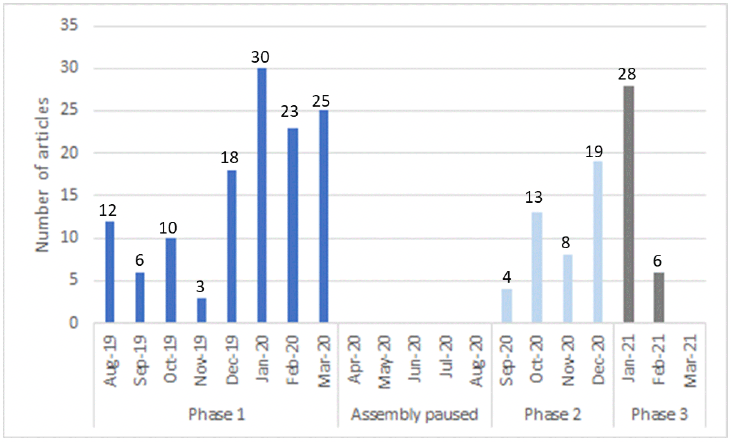
This general pattern of attention was not distributed equally among news outlets. Most of these articles appeared in the Herald (38) followed by the National (29) and Scotsman (16), with article numbers in the single digits for all other newspaper outlets in Scotland and the UK. The Herald and Scotsman alone have a combined monthly reach of 1.63 million but the vast bulk of the traditional media market share in Scotland is made up of four UK-wide national newspapers (around 85%) who devoted negligible attention to the Assembly. The Sun, the Mail, Mirror and Express, which have a monthly reach of almost 11 million, produced a total of 14 articles (Daily Express 4, Sun 4, Daily Mail 3, Mail on Sunday 2, Sunday Mail 1, Mirror 0), or just over 6% of the media coverage of the Assembly. What is clear from the media analysis is that the newspapers with the widest reach in Scotland failed to devote sustained attention to it, which is something of an obstacle for generating public awareness.
Figure 20 summarises changes in content over time. Much of the coverage during Phase 1 focussed on the Assembly process and content of discussions (27%) compared to, for example, issues of cost (7%), legitimacy (7%) or potential impact (13%). Political and ideological coverage, the second most popular source of content (14%), included discussions of the Assembly with respect to particular constitutional solutions or the relationship between political parties or other stakeholders and the Assembly. By Phase 2, however, the content of the coverage had changed, with far greater emphasis on the potential impact (40%) of the Assembly's recommendations and far less on process (5%). By Phase 3 the most frequent source of media coverage was discussions about the Assembly's outputs (45%), namely recommendations, in particular about the four-day week, rent caps and tax. In addition, across these themes the coverage was predominantly positive. This includes 51% general positive stories, 35% neutral and only 12% generally negative over the period the media were monitored.
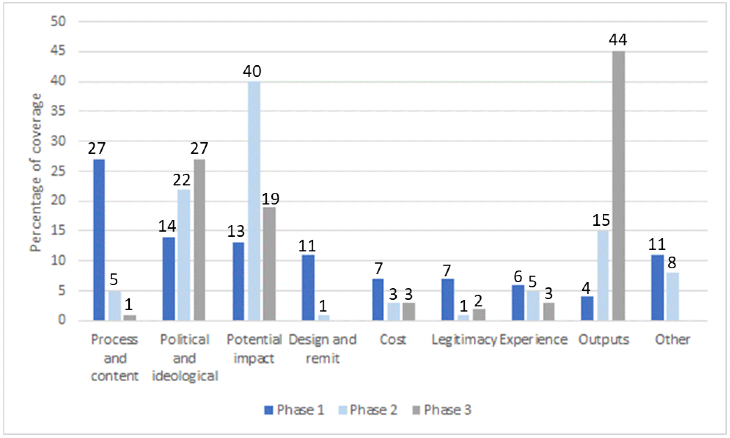
Various insights emerge from this analysis. First, the coverage would have failed to reach the average Scot as the greatest coverage of the Assembly was in a broadsheet with 1% of the newspaper market share. That said there is clear evidence that the coverage tracked the rhythm of the Assembly, with greater attention to its outcomes at the end and to its process and remit at the start. And the coverage was overwhelmingly neutral or positive. There was very little criticism or cynicism in the reporting, a fact borne out by the low levels of attention to critiques of legitimacy or complaints about cost.
Interviews
In interviews, those engaged with the organisation of the Assembly expressed disappointment with the level of coverage, attributing low levels of attention to the wide remit as well as to the competition within the news cycle as the COVID-19 pandemic emerged. They also identified a deliberate change in communications strategy, with an effort to highlight the experiences and 'back stories' of individual members as a way to sustain media interest as the Assembly progressed.
The external and internal interviews point to three particular challenges. These include, first, the initial announcement, which paired a citizens' assembly with the referendum bill, giving the impression that the Assembly was designed as a cover to provide wider justification for pressing on with plans for a second referendum. As one opposition MSP reported: 'My first impression – again just being totally honest about this – my first impression was that this is going to be a Government stitch up'. Second, the broad remit, which made it difficult for journalists to provide in-depth and changing coverage of a single issue as the discussions of the Assembly uncovered different facets of it, provided little purchase for journalists. As one MSP remarked: 'To be honest, I don't think most people registered it because I don't think most people even knew it was there'. Third, the COVID-19 pandemic altered both the form of the Assembly, suspending it temporarily and then served thereafter as a competitor for media attention. As one civil servant commented: 'Public engagement is harder, I think it wasn't a very easy environment, public engagement, during a pandemic'.
Interviews with journalists identified other constraints. They typically agreed that the wide remit made it difficult to provide in-depth coverage or key debates, as might be possible with an Assembly exploring a single issue. The result, they explained, was media coverage that tended to focus on the process of the Assembly. Having produced various articles on process however, there was little to warrant repeat stories until specific recommendations emerged. Local papers opted from time to time to cover stories about members from their particular area, but national newspapers waited for the recommendations. In Chapter 5 we offer further analysis of media coverage and elite perceptions of the Assembly.
How is the Assembly perceived by the Scottish public?
If we want to examine what the public thinks about the Assembly we can distinguish among different themes. This includes awareness of the Assembly as well as evaluations of its process, in this case the Assembly's recommendations. For awareness and for evaluations of process we can also check to see if public assessments change over the course of the Assembly.
In terms of awareness, majorities of the public were unaware of the Assembly or of citizens' assemblies in general although this decreased over time. In October 2019, 65% answered 'don't know' when asked to describe what the Assembly did. By February 2020 this was unchanged. By March 2021, just under half (49.7%) responded 'don't know' when asked what the Assembly was for. This is consistent with scores on subjective knowledge. Asked how much they felt they knew about the Assembly, only 3% in October 2019 indicated they knew a lot about it (selected 8, 9 or 10 out of 10). By February 2020 this remained unchanged. By March 2021 this increased by only one percentage point. By comparison, the proportion saying they knew a lot (8, 9 or 10 out of 10) about the Scottish Parliament was 25% in October 2019, 29% in February 2020 and 25% in March 2021. One might well hope such figures to be higher in the months before an election to the Scottish Parliament, but figures for the UK Parliament are not dissimilar: 26% in October 2019, 29% in February 2020 and 23% in March 2021. In short, knowledge of the Assembly increased by one percentage point over the course of the Assembly, but in reaching a high of less than five percentage it was very low when compared to subjective knowledge of other political institutions, and the subjective knowledge scores were not themselves particularly high.
In February 2020, less than a quarter (22%) believed that the Assembly gave 'citizens a chance to discuss issues facing Scotland', a figure which remained constant three months later, but had increased to just under a third (32%) by March 2021. From February 2020 to March 2021 around 10% consistently believed the Assembly was about finding solutions to issues facing Scotland such as poverty or climate change. Small minorities believed it was so Assembly members could talk about independence or so politicians could talk to each other (5%). Positively, while members of the public did not report knowing much about the Assembly, very few were prepared to label it as a talking shop for the political elite. Over time there was a remarkable amount of stability in these responses, with the exception of a large jump by March 2021 indicating it was to discuss issues facing Scotland (see Figure 21). This coincides with a marked increase in media attention to the consequences of the Assembly in Phase 2 and a focus on its outputs in Phase 3. To assess whether media coverage was likely to be responsible for changed awareness, we can track levels of public engagement with the Assembly, including sources by which they would have acquired information about it.
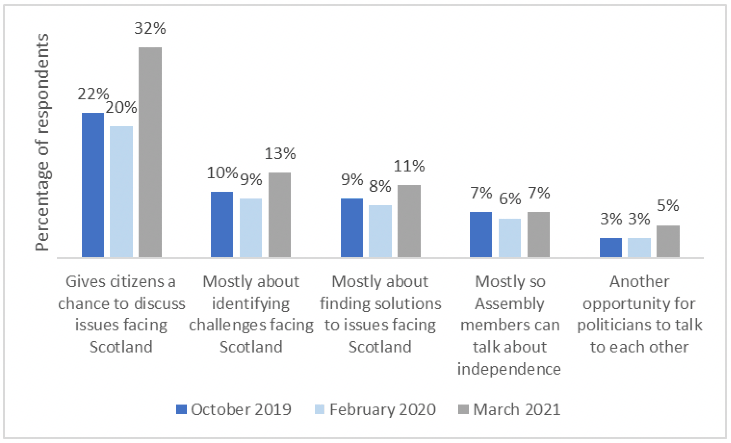
Source: Population survey (Question: Different people have different understandings of the Citizens' Assembly of Scotland. If you had to describe what it does, what would you say?)
Engagement with the Assembly
Levels of engagement with the Assembly were low throughout its duration. In October 2019, 89% claimed to have had no engagement with the Assembly, a figure reduced by one percentage point by February 2020. By March 2021 almost four in five (78%) professed to have had no engagement with the Assembly at all. While this might seem a substantial drop in disengagement, this still indicates that by the end of the Assembly just under eight in ten reported having no engagement with it at all.
Rates of engagement across the various possible forms did not change substantially over time. By March 2021, 7% had read articles about it (which is, admittedly, double the figures for earlier periods), 6% had heard about it via TV or radio, 4% followed or discussed it on social media, 4% discussed it with family or friends, 4% heard about it from political parties, 3% visited the Assembly's website, and 2% discussed it with work colleagues. What this suggests is that mainstream media channels (newspapers, television or radio) were the greatest form of engagement (and thus information) about the Assembly. Since the analysis presented earlier demonstrates that the largest newspapers provided minimal coverage this highlights an obvious missed opportunity in terms of public awareness and engagement. By contrast, evidence of diffuse engagement via social media, friends, family or work is very limited. In addition, 2% (27 respondents) indicated that they had volunteered for Scotland's subsequent Climate Assembly, a feature which is not currently possible, so we should also treat proffered levels of engagement as, if anything, prone to over-estimation.
Evaluations of the Assembly
To understand public evaluations of the Assembly we can distinguish between attitudes to Assembly process and attitudes to its outputs, in this case whether it has fulfilled its general remit and whether members of the public support its specific recommendations.
In three surveys across the different phases members of the public were asked whether they supported the use of citizens' assemblies to identify key challenges facing Scotland, whether they supported them proposing policy solutions for the challenges Scotland faces, and whether they felt they should identify constitutional options for Scotland (see Figure 22). Each of these questions were phrased as options from 0 (strongly against) to 10 (strongly in favour). The results in Figure 20 show that across Phases 1 and 2 levels of support were relatively stable for each of the three possible roles of citizens' assemblies. By Phase 3, however, around the time when the recommendations were being debated and discussed in the media, support for each of these three possible roles increased. The second finding is that there are clear variations in support across the different possible purposes of citizens' assemblies, with lowest levels of support for identifying constitutional options, and greatest support for identifying challenges. This would seem to be something of a challenge for those who wish to involve citizens in decision-making. There appears to be broad public support for citizen engagement in identifying problems, but slightly lower levels of support for identifying solutions, and support drops lower still if those solutions involve the constitution.
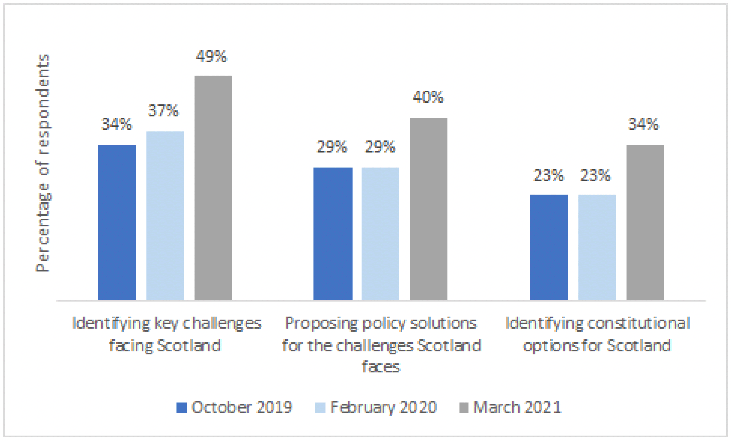
Source: Population survey (Question: Citizens' assemblies can do different things. How much would you be in favour of a citizens' assembly in Scotland doing each of the following?)
In the March 2021 survey, respondents were also asked whether they felt this particular Assembly had addressed its purpose. Here we see that 40% believe that the Assembly had answered the question 'what kind of country are we seeking to build', 38% felt it had addressed how to overcome the challenges Scotland and the world face in the 21st century, while 39% felt it had identified further work that should be carried out to give all of us living in Scotland the information we need to make informed choices about the future. These responses provided a plurality – more agreed than disagreed – but are low in part because at least 35% responded 'don't know' to each question. This is further evidence that public levels of awareness were not high. There is broad support for the ability of assemblies to frame problems, and support for the Assembly's work, as well as plurality support for the fact that it has addressed its remit, but levels of awareness and engagement are low.
Attitudes to recommendations
In terms of attitudes to the specific recommendations themselves, the results in Table 4 show that there was majority support for each of the Assembly's recommendations, ranging from 56% support for a central bank account for each citizen at birth to 82% for the introduction of a living wage. There are interesting patterns worth highlighting. Constitutional changes earned lower levels of support, largely due to higher levels of opposition. In contrast, lower levels of support for mini-publics (such as citizens' assemblies) or bank accounts stem more from higher levels of 'don't knows' rather than opposition to the proposal as such.
| Strongly disagree | Disagree | Agree | Strongly Agree | Total Agree | Don't know | |
|---|---|---|---|---|---|---|
| Living wage | 3 | 6 | 35 | 47 | 82 | 9 |
| Ban non-biodegradable waste | 4 | 6 | 40 | 41 | 81 | 11 |
| Rent caps | 3 | 7 | 42 | 35 | 77 | 12 |
| Criminal justice review | 3 | 7 | 43 | 34 | 77 | 13 |
| Higher NHS wages | 3 | 10 | 33 | 43 | 76 | 11 |
| Raise minimum wage for 12-24 year olds | 4 | 9 | 38 | 37 | 75 | 13 |
| No zero hours contracts | 7 | 10 | 30 | 40 | 70 | 14 |
| Lower state pension age | 6 | 11 | 37 | 31 | 68 | 15 |
| Traffic light tax compliance | 4 | 9 | 37 | 31 | 68 | 18 |
| Devolve further tax powers | 9 | 12 | 33 | 33 | 66 | 14 |
| Control over immigration | 11 | 12 | 31 | 32 | 63 | 14 |
| More mini-publics | 7 | 10 | 42 | 21 | 63 | 20 |
| Greater powers for international relations and trade | 11 | 13 | 30 | 31 | 61 | 15 |
| Ethically invest in society with central bank accounts | 11 | 16 | 31 | 25 | 56 | 18 |
There are reasons to be cautious with the interpretation of these results due to limitations of the data. Many of the recommendations are technical issues of governance and tax on which citizens may not have pre-formed views. This is not to say that they are not capable of generating such views but that these responses are likely to be first impression responses and as such are likely to be more malleable in general, as well as responsive to strong priming and framing effects. Second, we know that those most supportive of the Assembly were also more supportive of its recommendations but we are unable to tease apart which came first – whether they were more supportive of the recommendations because they trusted the Assembly, or whether they were more supportive of the Assembly because they liked particular recommendations.
Do public attitudes towards assemblies vary?
Just as individuals read different papers and exhibit different forms of possible engagement with the Assembly, so too are there variations in support. Here we focus not on variations in support of particular recommendations (in other words whether some recommendations are supported more than others) but whether certain members of the public are more likely to support citizens' assemblies.
To analyse public support we can focus on two possible questions: first, whether members of the public support the idea of citizens' assemblies in principle (measured here as support for the recommendation to hold more mini-publics). Second, whether they support this Assembly in practice (measured here as support for the view that the Assembly has answered its core question: What kind of country are we seeking to build).
To test this we identified a range of variables that might make a difference. These include age (measured here on a scale from 0 youngest to 1 oldest), gender (male/female), university (whether the respondent holds a degree=1), newspapers (whether they say they get most of their information about challenges facing Scotland from newspapers = 1), right wing (measured here on a scale from 0 left to 1 right), an activity index (a composite index measuring activity across eight different indicators in formal and informal politics), political party identification, Scottish National Party (SNP) supporter and independence support (where for all of these 1 = yes and 0 = no).
There are various reasons why we might expect varying support in principle or practice. We might anticipate that those who are more engaged are more supportive. This would include those who exhibited greater media exposure to newspapers (since this was the largest form of engagement with the Assembly), those who identify with any particular party, or those who have higher scores on a composite political activity index. Likewise we might expect that those who are supporters of the SNP or supporters of independence would be more supportive, partly because it the Assembly was announced by the SNP Government and partly because it was announced at the time of a referendum bill and there was, based on the interview material, an expectation that the Assembly would identify possible constitutional options for Scotland. If we analyse the effect of each of these variations – as well as controls such as age, gender and political ideology – on support for citizens' assemblies in principle, then a political predisposition to support the Scottish Government (being an SNP supporter or pro-independence) makes one markedly more likely to support mini-publics. Most of the other variables did not produce significant effects, but women were significantly more likely to support them while university graduates and those who described themselves as right wing were not (Figure 23).
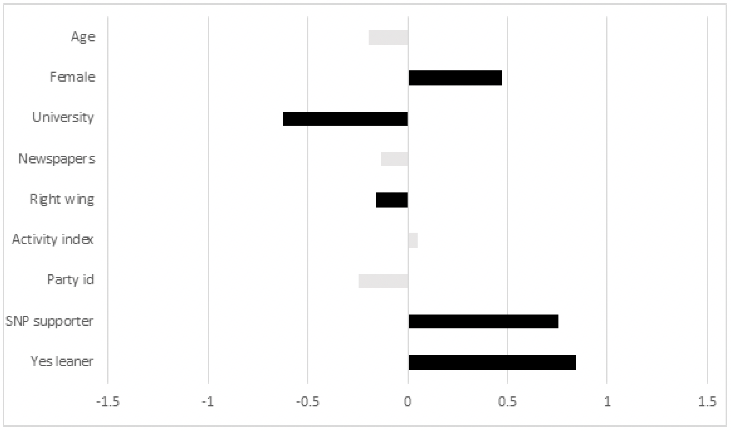
Results are coefficients for logistic regression. Black bars indicate statistically significant coefficients (p<.05) while grey bars are not significant.
As for support for this Assembly, we see some important differences (Figure 24). Women remained more supportive and university graduates less so. But we also found that older people were markedly less likely to believe that the Assembly successfully addressed its core question. SNP supporters were less enthusiastic than they were about mini-publics in general, but those who support Scottish independence are more supportive of this Assembly than mini-publics in general. In addition, just having a party identification made no difference to how one evaluated mini-publics, but was significantly related to how one felt about this Assembly and its achievements. Those who felt close to a political party, regardless of which party it was, were more supportive of this Assembly.
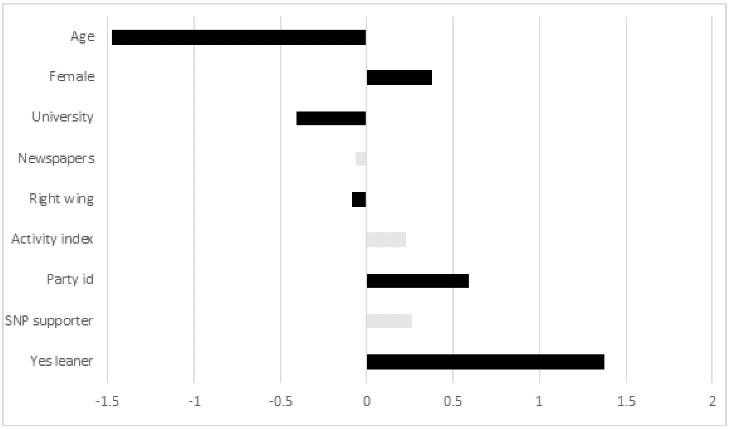
Results are coefficients for logistic regression. Black bars indicate statistically significant coefficients (p<.05) while grey bars are not significant.
To evaluate why SNP supporters appeared to hold different views of mini-publics in general and of the Assembly in particular we conducted additional analysis to identify whether SNP supporters – or indeed pro-independence supporters – were different from the general public on other variables, and thus whether these factors, rather than party support or constitutional preferences, can explain things. If we add in new variables and these variables are significantly related to evaluations of assemblies but SNP and Yes support are no longer significant then we have found an explanation for why party preferences appears to structure support for assemblies. We have added additional variables we know often structure political engagement. These include ethnicity, income and levels of efficacy, and have distinguished between internal efficacy – a sense that one can make a difference – and external efficacy – a sense that the system is responsive to change.
Once these new variables have been added, identifying with the SNP is not statistically significant in any model. Measures of internal efficacy are not significant either, but external efficacy, in other words a sense that the political system is responsive to change, are significantly related to support for mini-publics. It is therefore not the case that SNP supporters are more supportive of assemblies in principle because they voted for the current Government in 2016 and are disappointed that this Assembly did not propose particular constitutional options, but instead that they are more supportive of mini-publics because they believe the system is responsive to their action.
Conclusion
This chapter offers something of a mixed assessment of public attitudes to the Assembly. On the one hand, levels of awareness and engagement were low, explained in part by the challenging media environment in which the Assembly would have been covered but also by the particular pattern of media coverage. This includes coverage that was front-ended, process-heavy and with much of it concentrated in a handful of papers. In general the Assembly was largely neglected by those papers with the largest readership in Scotland. The consequences of this were low levels of subjective knowledge of the Assembly.
That said, support for assemblies in principle rose over the duration of the Assembly, peaking around the time of the recommendations when the content of media coverage also changed. In addition, there was majority support for all of the Assembly's recommendations, admittedly with more controversy around those tied to the constitution, committing substantial resources or linked to reserved areas of policy jurisdiction. One additional encouraging note may be found in attitudes to future involvement. At the end of the Assembly, more than two thirds (70%) of the general public said they would have been likely to accept an invitation to take part in the Assembly.
An analysis of variations in support shows that those who are more politically engaged are more supportive, but that this is particularly true for supporters of the Government. Their attitudes are better explained by their sense of efficacy in the wider political system rather than their constitutional preferences as such. This finding, when coupled with greater levels of support for assemblies to identify challenges rather than solutions, may be interpreted as a possible constraint on public support for the greater use of citizens' assemblies in Scotland.
Contact
Email: socialresearch@gov.scot
There is a problem
Thanks for your feedback